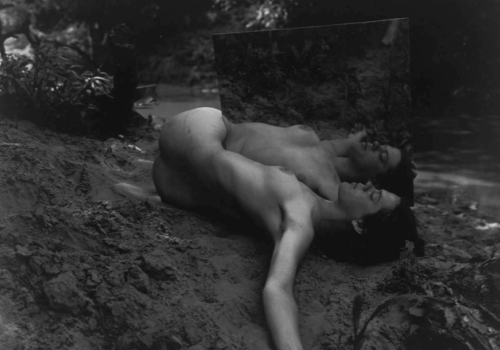Since its founding in 1990, the Danziger Gallery has established itself as one of the leading photography venues in the world, known for the originality and diversity of its programming, its representation of established photographers, and the influence of its new discoveries.
Naked bodies twist and contort and are reconstructed, as in an off-kilter kaleidoscope, by duplication in mirrors; and then they are photographed. The results are radical and surpris- ing images that tease the viewer’s perceptions. The sculptor’s most timeless subject, the human figure, is dramatically revisited in this series of “Body/Sculptures” made by Hans Breder between 1969 and 1973.
When I was first shown these photographs, I was immediately intrigued and, thinking out loud, embarked on an enthusiastic stream-of-consciousness monologue as I felt my way, in sponta- neous phrases and suggestions, towards an analysis of what had so impressed me. These obser- vations involved reflections both on the integral constituents of the images and on the place of this engaging body of work within the broader story of what was happening in the art scene in those years. A subsequent invitation to pen a few sentences of introduction to the series was irresistible.
It took me a while to unravel my strong initial response to this insistent set of images, images that provoke the viewer around issues of ambiguity and interpretation, reality and illusion. They do this cleverly, obliquely, by subverting the various disciplines out of which they are born. Breder’s “Body/Sculptures,” as he called them, made either in his studio or in architectural settings, in the landscape or at the water’s edge, involve still, anonymous, often foreshortened naked bodies. So far so seemingly straightforward. The disorienting element is provided by the inclusion within each construct of one or more mirrors, held in place by the subjects and serving at once to truncate and to replicate different body parts, and so confuse our eye.
Breder is an inter-media artist whose work and teachings have involved a willful collision of disci- plines. In this series, he found a perfect formula through which to associate the physical authority of sculpture, the ephemerality of performance, and the illusionistic potential of the photograph.
Working with his models — who include dancers and the performance artist Ana Mendieta — Breder first creates his “sculpture,” guiding his subject or subjects towards three-dimensional poses, incorporating judiciously placed mirrors to create an equally distinct yet intangible fourth dimension. This ephemeral event is only the first stage in the creative process. His next step is to make a photographic record from a fixed vantage point. The camera’s monoscopic reading of the subject dissolves the possibility of depth-perception and presents a flat, puzzling, illusionistic field in which the elements of the body that are merely mirror images become as credible, as seemingly substantial and tangible as the body itself. Without any photographic trickery, Breder turns his living sculpture into a two-dimensional riddle that challenges our eye and our reasoning.
The late 60s contemporary art scene in which Breder conceived and executed these works bore no relation to the global, high-profile market phenomenon this has become today. Breder was from a generation of artists whose motivation was experimentation and exploration rather than the making of concrete artworks. Yves Klein’s Saut dans le vide (“Leap into the void”) of 1960 was an emblematic clarion call. Klein became a spiritual godfather to artists across the globe who sought to subvert the traditional hierarchies of art and whose activities frequently involved art without material limitations — artists as distinct and diverse as American Dennis Oppenheim with his temporal landscape interventions, as the anarchic Viennese Actionists, or the young British performance duo Gilbert and George — manifestations as ground-breaking and invigorating as Dada had been a half-century earlier.
While Breder’s work in various media — notably sculpture, video, and painting — can be traced through museum and gallery exhibitions, remarkably, his photographs are unknown. They emerge as indicative of this artist’s unique sensibility and of his rare instinct for the fruitful cross-pollination of disciplines and of ideas.
— Philippe Garner London, October 2015
FAIR
Paris Photo 2015
From 12 to 15 November, 2015
Grand Palais
Avenue Winston Churchill
75008 Paris
France
















